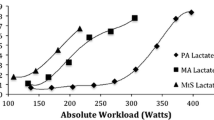Summary
Four groups of subjects of different ages and sex (group I: 20–29 years, women; group II: 20–29 years, men; group III: 30–39 years, women; group IV: 30–39 years, men) undertook dynamic one-hand work (load range 40%–80% of maximum voluntary contraction, at 60 working cycles/min) to allow a study of cardiovascular responses as shown by the resultant changes in blood pressure and heart rate. During fatiguing dynamic one-hand work, there was a large increase in systolic and diastolic blood pressures in both sexes after a few minutes. For all load levels, the systolic blood pressure was found to be higher by about 4 kPa in men (groups II and IV) than in women (groups I and III). Other age-related differences became evident in the diastolic blood pressure changes. The values obtained for the older groups were higher than those in the two younger groups. These differences in blood pressure response are possibly due to sex-related differences in the release of catecholamines, or to age-related organic changes in the vessels.
Similar content being viewed by others
References
Asmussen E, Hemmingsen I (1958) Determination of maximum working capacity at different ages in work with the legs or with the arms. Scand J Clin Lab Invest 10:67–71
åstrand PO, Ekblom B, Messin R, Saltin BS, Stenberg J (1965) Intra-arterial blood pressure during exercise with different muscle groups. J Appl Physiol 20:253–256
Bevegård S, Freyschuss U, Strandell T (1966) Circulatory adaptation to arm and leg exercise in supine and sitting position. J Appl Physiol 21:36–46
Bezucha GR, Lenser MC, Hanson PG, Nagle FJ (1982) Comparison of hemodynamic responses to static and dynamic exercise. J Appl Physiol 53:1589–1593
Blomqvist CG, Lewis SF, Taylor WF, Graham RM (1981) Similarity of the hemodynamic responses to static and dynamic exercise of small muscle groups. Circ Res 48:I-87–92
Bobbert AC (1960) Physiological comparisons of three types of ergometry. J Appl Physiol 15:1007–1014
Collett ME, Liljestrand G (1924) The minute volume of the heart in man during some different types of exercise. Scand Arch Physiol 45:29–42
Einars W (1979) Elektromyographie als arbeitswissenschaftliche Methode zur Beurteilung von lokaler Belastung, Beanspruchung und Ermüdung bei dynamischer Muskelarbeit. Dissertation, Technische UniversitÄt München
Ernst E, Matrai A (1984) Bluthochdruck — einmal anders gesehen. Z Allgemeinmed 60:598–603
Kindermann W, Schnabel A, Schmitt WM, Biro G, Cassens J, Weber F (1982) Catecholamines, growth hormone, cortisol, insulin, and sex hormones in anaerobic and aerobic exercise. Eur J Appl Physiol 49:389–399
Kobryn U, Hoffmann B (1983a) Analyse und Bewertung lokaler dynamischer Muskelarbeit — Auswirkungen ermüdender Belastung auf Parameter des motorischen und Herzkreislaufsystems. Z Gesamte Hyg 29:461–463
Kobryn U, Hoffmann B (1983b) Physiological effects of dynamic hand work in subjects of different age and sex. Eur J Appl Physiol 51:145–154
Laurig W (1974) Beurteilung einseitig dynamischer Muskelarbeit. Schriftenreihe Arbeitswissenschaft u Praxis, vol 33. Beuth-Vertrieb, Berlin, Köln, Frankfurt/M
Lewis SF, Taylor WF, Graham RM, Pettinger WA, Schutte JE, Blomqvist CG (1983) Cardiovascular responses to exercise as functions of absolute and relative work load. J Appl Physiol 54:1314–1323
Petrofsky JS, Lind AR (1975a) Aging, isometric strength and endurance, and cardiovascular responses to static effort. J Appl Physiol 38:91–95
Petrofsky JS, Lind AR (1975b) Isometric strength, endurance, and the blood pressure and heart rate responses during isometric exercise in healthy men and women, with special reference to age and body fat content. Pflügers Arch 360:49–61
Petrofsky JS, Burse RL, Lind AR (1975) Comparison of physiological responses of women and men to isometric exercise. J Appl Physiol 38:863–868
Rost R (1979) Kreislaufreaktionen und -adaptationen unter körperlicher Belastung. Osang, Bonn
Sanchez J, Pequignot JM, Peyrin L, Monod H (1980) Sex differences in the sympatho-adrenal response to isometric exercise. Eur J Appl Physiol 45:147–154
Schnauber H, Müller EA (1970) Die LeistungsfÄhigkeit der HÄnde bei Arbeit in verschiedener Höhe über dem Herzen. Int Z Angew Physiol 28:135–154
Stenberg J, åstrand PO, Ekblom B, Royce J, Saltin B (1967) Hemodynamic response to work with different muscle groups sitting and supine. J Appl Physiol 22:61–70
Author information
Authors and Affiliations
Rights and permissions
About this article
Cite this article
Kobryn, U., Hoffmann, B. & Ransch, E. Sex- and age-related blood pressure response to dynamic work with small muscle masses. Europ. J. Appl. Physiol. 55, 79–82 (1986). https://doi.org/10.1007/BF00422898
Accepted:
Issue Date:
DOI: https://doi.org/10.1007/BF00422898




